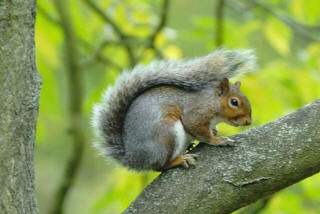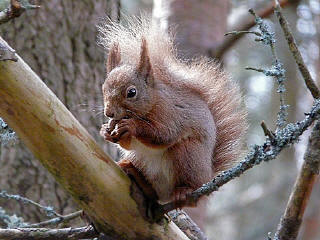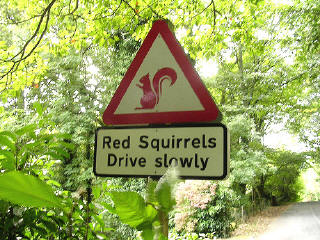Article
Squirrels and How to Photograph
them
| The word squirrel, first attested in 1327,
comes via the Anglo-Norman language.
Squirrels belong to the most successful and
widespread order in the world, rodents. One of the main differences between
squirrels and most other rodents is that they have a large, bushy tail. All
rodents are gnawing animals and squirrels have well-developed jaw muscles and
chisel-like front teeth that can chew through just about anything. These front
teeth are kept sharp by gnawing on hard objects such as woody plant materials,
seeds and nuts, but this diet has another purpose as their teeth continually
grow and if they did not keep their teeth at a manageable level they would not
be able to eat and therefore would starve. They are basically vegetarians and
eat a wide variety of plants of mostly nuts and fruit.
|

  |
Rodents are known for their high
reproductive rate and squirrels are no exception usually producing
2 litters each year. The first litter is born in January or February while the
second arrives in mid-summer. Young squirrels mature rather slowly for a rodent
and are on their own in about two and a half months.
They
are usually active during the daytime. This characteristic makes their
activities quite noticeable to us. They rely on their keen senses to detect
danger when it is still some distance away and then they make a quick escape.
Squirrels in the UK
|
Within the UK there are two species of squirrel the Red, which is native to the
UK, and the Grey which although imported is now probably the most recognised
species being found in many forests, city/town parks and gardens.
A decline of the red squirrel and the rise of
the grey squirrel has been widely remarked upon in British popular culture. It
is mostly regarded as the invading greys driving out the native red species.
Currently the red squirrel only resides in a few isolated areas of the UK,
notably in Scotland, and in the north of England, the Lake District and the Isle
of Wight, in Northern Ireland they can be found in Co. Fermanagh, Co. Antrim,
Co. Londonderry and Co. Down. Special measures are in place to contain and
remove any infiltration of grey squirrels into these areas to protect the Red
species. |
 
 by
Donald Noble
by
Donald Noble
 |
In a survey I came across from around 2006 it
is believed the population of the British Red Squirrel is estimated to be
161,000 which is broke down into 30,000 in England, 10,000 in Wales and 121,000
in Scotland. Whilst the British Grey Squirrel population is estimated at
2,520,000 with 2 million in England and because of this under British law, the
Grey squirrel is regarded as a pest, and it is illegal to release any into the
wild; any caught must be either killed or kept captive.
The grey squirrel population appears to be able
to out-compete the red squirrel for various reasons:
- The grey can easily digest acorns, while the
red squirrel cannot.
- The grey squirrel carries a disease, the
squirrel parapoxvirus, that does not appear to affect their health but will
often kill the red squirrel.
- When the red squirrel is put under pressure,
it will not breed as often.
It is worth noting that the grey squirrel and
the red squirrel are not directly antagonistic towards each other, and direct
violent conflict between these species is not a factor in the decline in red
squirrel populations.
Research undertaken in 2007 in the UK credits
the Pine Marten with reducing the population of the invasive grey squirrel in
the UK. Where the range of the expanding Pine Marten population meets that of
the grey, the population of these squirrels retreats. It is theorised that
because the grey squirrel spends more time on the ground than the red, that they
are far more likely to come in contact with this predator.
For more details on each of these types
including characteristics and behaviour see our fact file pages at:
|
Red Squirrel
Fact File

Grey Squirrel
Fact File

Photographing Squirrels
Photographing Grey Squirrels is not as big a
challenge as that of the Red as they are prolific all over the UK. You will find
them in local woodlands, city/town parks, in the country or town, and even in
gardens, I have also seen them in school grounds. The Red Squirrels on the other hand are
only found in a few areas of England and Wales and are more widespread in
Scotland. Our listing on where to photograph
Red Squirrels in the UK
 should help you identify some locations you should
be able to see them at. Although remember they are wild so there is no guarantee
you will successfully see and photograph them on your visit. should help you identify some locations you should
be able to see them at. Although remember they are wild so there is no guarantee
you will successfully see and photograph them on your visit. |
 
 by
Edward (Deluxe) by
Edward (Deluxe)
 |
So once you've identified
your location what should you do next. Well the first thing is to think about
the kit you might want to take with you. Remember it may not be possible to get
the shots you plan for on the other hand in most cases there will also not be
enough time to sit and change lenses or attachments once in position, firstly
because they move fast, but also if you are lucky enough to get them to come
close to you, then any movement on your part may cause them to run. A longer zoom
telephoto lens is probably a good all round lens that will get most of the shots
you want, and remember you can always crop the image later if it's not quite
near enough for you as long as you have allowed enough depth of field. Again
this could be tricky because in most cases your location will be in woodland and
light may be limiting.
Once you've decided on your kit, get to your
location here are some tips on how to get those great photos:
- Use
white balance on PRE,
 make it the first thing you do when you get to your desired spot, that way
your squirrels will look the colour you expect.
make it the first thing you do when you get to your desired spot, that way
your squirrels will look the colour you expect.
- Crouch as low on the ground as possible and
stay still and quiet.
- Rest your elbows on a static object, for
example a rock or use a tripod, to keep your gaze steady.
- If possible, avoid using the flash which may
startle the squirrel or cause your pictures to come out red-eyed.
- Take along some peanuts (not salted) to
offer and allow the squirrel to get up close.
- Motion shots need to think about panning or
focusing on the point ahead of where they are at. They move fast and you will
probably miss more than you get.
- Identify those places that they like to be,
if you can sit and watch a while you'll be able to work out behaviours and
individual characters.
- Wait until the squirrel settles momentarily
and then snap several pictures, which will help you capture a more interesting
pose, for example nibbling on a nut.
- Be patient - good things come to those who
wait.
- Remember - wildlife comes first - if you
appear to be distressing the animal or causing it to miss out on food, move
away and find another subject.
See Also
Wildlife photography

Equipment suitable for
wildlife photography

Hides and camouflage

Animal Behaviour

General tips on
photographing wildlife

Where to
photograph Red Squirrels
 |